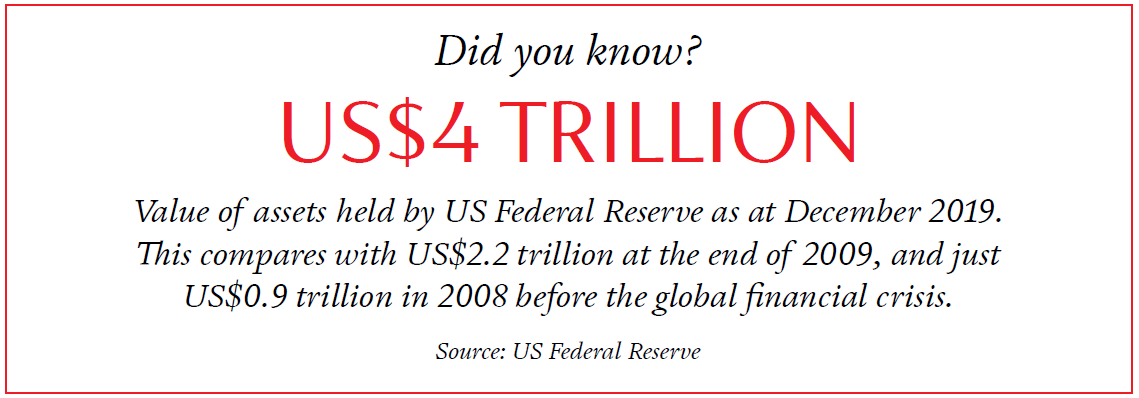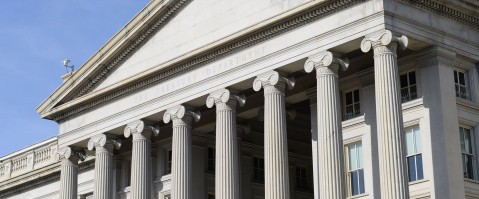
Economic policies: A new era
Governments are looking beyond traditional policies for when the global economy next needs a boost.
4 min read
Once seen as a last resort to avert economic catastrophe, ultra-loose monetary policy is losing its allure. Interest rates have been stuck at historic lows since the end of the financial crisis and show no signs of making significant rises. In the meantime, central banks have bought trillions of dollars of bonds to add money to the system, a process known as ‘quantitative easing’ (QE)
But inflation remains low and growth unexceptional given the levels of stimulation applied over the decades. As economies seem less reactive to these traditional remedies, economists and politicians are now questioning whether traditional monetary policy will be able to tackle future economic crises.
Furthermore, the nature of the challenges facing the world has changed dramatically. The economic problems that traditional fiscal and monetary policies are designed to combat now look modest compared with rising concerns over wealth inequality and, especially, global warming.
So, what options do governments have to stimulate their economies if traditional policies become ineffective? Two ideas are gaining currency in policy circles: modern monetary theory and ‘helicopter money’.
Unleashing the power of currency
Modern monetary theory (MMT) proposes that governments could simply use central banks to create the money to fund spending.
Countries that have their own central banks and borrow in their own currencies – the US, UK, and Japan, for example – can’t default on their debt. As long as they can print money, they could keep going until every person is employed and inflation finally kicks in.
“With low interest rates and huge injections of liquidity through quantitative easing the new normal, governments are looking at other ways to spur growth.”
Critics say MMT ignores the impact of increased borrowing costs, loss of confidence in international markets and the negative impact on productivity from excess debt. But, it gives governments a new way to fund major projects. It’s typically raised as a way to fund progressive legislation like universal healthcare and other expensive public programmes like the ‘Green New Deal’ in the US.
Helicopter money as a crisis-fighting tool
Unlike traditional QE, where liquidity is made available to banks and financial institutions, ‘helicopter money’ is about handing cash directly to individuals.
One of the big problems with QE has been that it has mainly ended up in stock markets, supporting asset prices but not doing much for economic growth. Conversely, an injection of cash directly to consumers, the theory goes, will be much more efficient at stimulating demand and moving inflation.
Like MMT, helicopter money has potential problems. Once people know that central banks can just hand out cash in times of crisis, they may come to demand it in ever less extreme circumstances. And the lesson of QE – once seen as an extreme measure – is that a one-off move can quickly become the default option.
The way it changes a government's entire perception of the choices facing it is also dangerous – what impact might a helicopter of cash have in the months leading up to a general election?
If enacted, helicopter money would need strict limits to make sure that such exceptional measures are not at the sole discretion of governments. For example, a system of automatic disbursements could be programmed for when certain economic criteria are met, taking decisions on timing out of the hands of government officials.

Become a Client
When you become a client of Coutts, you will be part of an exclusive network.
A new era needs new ideas
These types of stimulus could change the paradigm for investors. We naturally stay in touch with the latest ideas, and our ongoing analysis of the global economic environment will provide a basis for assessing its impact.
But how and where extra stimulus is applied would be key. Helicopter money aimed at general consumers could drastically soften the negative impact of recessions and lead to quicker recovery. Similarly, while financing long-term infrastructure projects could face capacity issues – there simply may not be the production capacity to put the money to use – it could help achieve higher growth potential and transition economies to a more sustainable model.
There is no doubt that these new ways of stimulating economies could deeply impact financial markets by smoothing out the business cycle and corporate earnings cycle. But, it could also exaggerate some market moves as large amounts of cash are released into the economy. And as with QE, these policies could end up triggering long-lasting changes to the underlying dynamics of the economy in unforeseen ways.
Key Takeaways
- Modern monetary theory suggests governments could simply direct central banks to ‘print money’ as a means of financing spending, for example on infrastructure projects
- ‘Helicopter money’ would give cash directly to individuals, who are more likely to spend than the institutions targeted by the usual monetary remedies
- Both represent a substantial change in the way economies are managed and could have profound economic and market impact
When investing, past performance should not be taken as a guide to future performance. The value of investments, and the income from them, can go down as well as up, and you may not recover the amount of your original investment.


.jpg.rendition.375.260.jpg)






